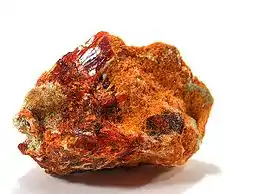Botryogen
Botryogen is a hydrous magnesium sulfate mineral with formula: MgFe3+(SO4)2(OH)·7H2O. It is also known as quetenite.[2]
| Botryogen | |
|---|---|
 Specimen from Mina Santa Elena, Alcaparrosa, San Juan, Argentina with a red colored crystal of botryogen in a matrix of butlerite, copiapite and parabutlerite (size:5.7 x 4.1 x 2.5 cm) | |
| General | |
| Category | Sulfate minerals |
| Formula (repeating unit) | MgFe3+(SO4)2(OH)·7H2O |
| Strunz classification | 7.DC.25 |
| Crystal system | Monoclinic |
| Crystal class | Prismatic (2/m) (same H-M symbol) |
| Space group | P21/n |
| Identification | |
| Mohs scale hardness | 2 - 2.5 |
| Specific gravity | 2.14 |
| References | [1] |
It crystallizes in the monoclinic prismatic system and typically occurs as vitreous bright yellow to red botryoidal to reniform masses and radiating crystal prisms. It has a specific gravity in the range 2 to 2.1 and Mohs hardness in the range of 2 to 2.5.[3]
It occurs in arid climates as a secondary alteration product of pyrite-bearing deposits.[4]
It was first described in 1828 for an occurrence in the Falu mine of Falun, Dalarna, Sweden. It was named for its grape like appearance from Greek botrys for "bunch of grapes" and genos meaning "to bear".[3]
References
- Mineralienatlas
- "Botryogen Mineral Data". webmineral.com. Retrieved 2019-11-03.
- "Botryogen: Mineral information, data and localities". www.mindat.org. Retrieved 2019-11-03.
- Mineral Data Publishing - botryogen.pdf
Further reading
- Palache, C., H. Berman, and C. Frondel (1951) Dana’s system of mineralogy, (7th edition), v. II, pp. 617–618.
This article is issued from Wikipedia. The text is licensed under Creative Commons - Attribution - Sharealike. Additional terms may apply for the media files.
